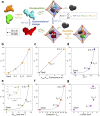Reconstructing reactivity in dynamic host-guest systems at atomistic resolution: amide hydrolysis under confinement in the cavity of a coordination cage
- PMID: 36320487
- PMCID: PMC9517058
- DOI: 10.1039/d2sc02000a
Reconstructing reactivity in dynamic host-guest systems at atomistic resolution: amide hydrolysis under confinement in the cavity of a coordination cage
Abstract
Spatial confinement is widely employed by nature to attain unique efficiency in controlling chemical reactions. Notable examples are enzymes, which selectively bind reactants and exquisitely regulate their conversion into products. In an attempt to mimic natural catalytic systems, supramolecular metal-organic cages capable of encapsulating guests in their cavity and of controlling/accelerating chemical reactions under confinement are attracting increasing interest. However, the complex nature of these systems, where reactants/products continuously exchange in-and-out of the host, makes it often difficult to elucidate the factors controlling the reactivity in dynamic regimes. As a case study, here we focus on a coordination cage that can encapsulate amide guests and enhance their hydrolysis by favoring their mechanical twisting towards reactive molecular configurations under confinement. We designed an advanced multiscale simulation approach that allows us to reconstruct the reactivity in such host-guest systems in dynamic regimes. In this way, we can characterize amide encapsulation/expulsion in/out of the cage cavity (thermodynamics and kinetics), coupling such host-guest dynamic equilibrium with characteristic hydrolysis reaction constants. All computed kinetic/thermodynamic data are then combined, obtaining a statistical estimation of reaction acceleration in the host-guest system that is found in optimal agreement with the available experimental trends. This shows how, to understand the key factors controlling accelerations/variations in the reaction under confinement, it is necessary to take into account all dynamic processes that occur as intimately entangled in such host-guest systems. This also provides us with a flexible computational framework, useful to build structure-dynamics-property relationships for a variety of reactive host-guest systems.
This journal is © The Royal Society of Chemistry.
Conflict of interest statement
There are no conflicts to declare.
Figures





Similar articles
-
Molecular Factors Controlling the Isomerization of Azobenzenes in the Cavity of a Flexible Coordination Cage.J Am Chem Soc. 2020 May 27;142(21):9792-9802. doi: 10.1021/jacs.0c03444. Epub 2020 May 14. J Am Chem Soc. 2020. PMID: 32353237 Free PMC article.
-
Proton-mediated chemistry and catalysis in a self-assembled supramolecular host.Acc Chem Res. 2009 Oct 20;42(10):1650-9. doi: 10.1021/ar900118t. Acc Chem Res. 2009. PMID: 19591461
-
Coordination Cages Based on Bis(pyrazolylpyridine) Ligands: Structures, Dynamic Behavior, Guest Binding, and Catalysis.Acc Chem Res. 2018 Sep 18;51(9):2073-2082. doi: 10.1021/acs.accounts.8b00261. Epub 2018 Aug 7. Acc Chem Res. 2018. PMID: 30085644
-
Interpenetrated Cage Structures.Chemistry. 2016 Sep 26;22(40):14104-25. doi: 10.1002/chem.201601752. Epub 2016 Jul 15. Chemistry. 2016. PMID: 27417259 Review.
-
Catalytic reactions within the cavity of coordination cages.Chem Soc Rev. 2019 Aug 27;48(17):4707-4730. doi: 10.1039/c9cs00091g. Chem Soc Rev. 2019. PMID: 31339148 Review.
Cited by
-
Catalysis of Synergistic Reactions by Host-Guest Assemblies: Reductive Carbonylation of Nitrobenzenes.JACS Au. 2023 Jul 18;3(8):2166-2173. doi: 10.1021/jacsau.3c00233. eCollection 2023 Aug 28. JACS Au. 2023. PMID: 37654585 Free PMC article.
-
Origins of High-Activity Cage-Catalyzed Michael Addition.J Am Chem Soc. 2024 Jul 17;146(28):19317-19326. doi: 10.1021/jacs.4c05160. Epub 2024 Jul 8. J Am Chem Soc. 2024. PMID: 38976816 Free PMC article.
-
Systematic exploration of accessible topologies of cage molecules via minimalistic models.Chem Sci. 2023 Oct 11;14(44):12506-12517. doi: 10.1039/d3sc03991a. eCollection 2023 Nov 15. Chem Sci. 2023. PMID: 38020374 Free PMC article.
-
Picking the lock of coordination cage catalysis.Chem Sci. 2023 Sep 8;14(41):11300-11331. doi: 10.1039/d3sc02586a. eCollection 2023 Oct 25. Chem Sci. 2023. PMID: 37886081 Free PMC article. Review.
-
Into the dynamics of rotaxanes at atomistic resolution.Chem Sci. 2023 May 30;14(24):6716-6729. doi: 10.1039/d3sc01593a. eCollection 2023 Jun 21. Chem Sci. 2023. PMID: 37350834 Free PMC article.
References
-
- Benner S. A. Chem. Rev. 1989;89:789–806.
-
- Arnold F. H. Wintrode P. L. Miyazaki K. Gershenson A. Trends Biochem. Sci. 2001;26:100–106. - PubMed
-
- Fang Y. Powell J. A. Li E. Wang Q. Perry Z. Kirchon A. Yang X. Xiao Z. Zhu C. Zhang L. Huang F. Zhou H.-C. Chem. Soc. Rev. 2019;48:4707–4730. - PubMed
-
- Zhang X. Houk K. N. Acc. Chem. Res. 2005;38:379–385. - PubMed
-
- Bender M. Kezdy F. Annu. Rev. Biochem. 1965;34:49–76. - PubMed
LinkOut - more resources
Full Text Sources
Research Materials

